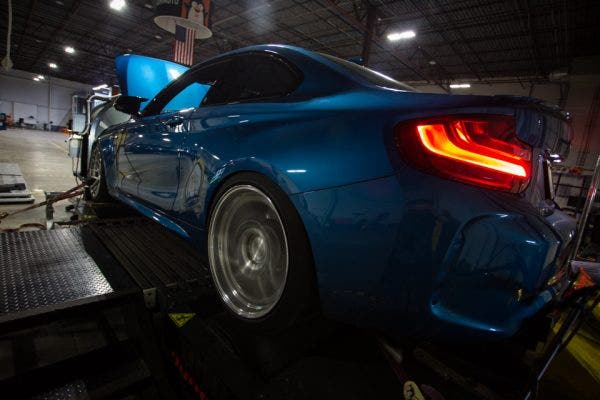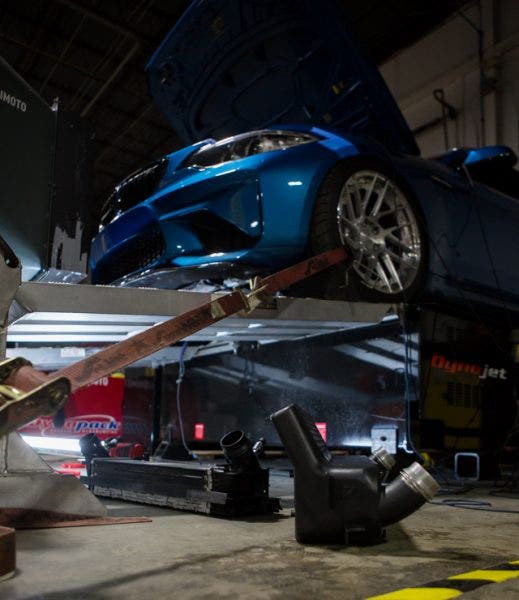
Ultimate Cooling - Performance Intercooler R&D, Part 4 - Testing Results
Everyone loves a dynamic character. Think about it. When have you ever read a book or watched a movie and said to yourself, "Wow, I'm really glad that the main character didn't develop throughout the story"? We long for that feel-good moment when the protagonist reaches a turning point and changes. The development for our F20/F30 intercooler has a relatable plot line.

R&D is a process with its own ups and downs. That's what makes it a challenge, and thus fun for us problem solvers. Even with a lot of research and simulations, some things lead to unexpected outcomes. If you look back through the beginning stages of our development, it's clear that we're taking a unique approach when it comes to the stepped-core intercooler. If you're worried that adding the angle to the top of our intercooler core was the part that worked out differently, never fear, it does its job. The topic of shrouding is the aspect that eventually took a different turn once we arrived at the testing phase.
Heavy Shrouding

No matter which specific 2, 3, or 4-Series you might have, there's still plenty of shrouding that seals the intercooler in place.
We all know that BMW is notorious for putting some serious engineering hours behind just about every component of their vehicles. When our first loaner car arrived here at our Delaware facility, one of the first things we noticed was the multitude of shrouding that sealed in place the intercooler and front-mounted heat exchangers. We figured that those German engineers were on to something and began developing different sets of shrouding of our own. However, when it came to the wide fitment list, we ran some extra wind speed testing to help narrow down which shrouds specifically we would need.


We ran this test in four parts. For each test, we fixed one of our airspeed meters to the front of our loaner M2 and took it for a spin to collect real world data on how the air flow hits the front end of the Bimmer. We ran the car with the stock intercooler and our core, both with and without shrouding, and found that the shrouding actually made little to no difference when added to our intercooler.
Under Pressure
When it comes to upgrading any turbocharged car, pressure drop is a hot topic that always comes up, especially if you're talking about larger intercoolers. Increasing the volume and packing the internal fins tight is bound to slow the airflow through the system and account for some drop in boost pressure. The hard truth is that pressure drop is inevitable when upgrading the intercooler, unless you like having an intercooler that easily heat-soaks.

Creating an aftermarket intercooler that performs is a balancing act, since we're looking to accomplish much of the following: a drop in charged air temperatures, maintained boost pressure, and additional power. We have to find an equilibrium with the core size and fin pitch to deliver. The stock unit has a fairly loose fin pitch and a smaller core, meaning it has a decent flow reading. However, that, combined with the tube-and-fin construction, means this core will soak up heat with ease.

Our core utilizes a bar-and-plate construction, which aids in the charged air flowing through the core. We did pack some extra fins inside the core, and crammed them closer together, but we were still able to drop the outlet temperatures and add power to your turbo-Bimmer all while keeping the pressure drop under 2psi.
The Real Test

Our new F20/F30 intercooler design might be a looker, but looks come second in the case of this performance intercooler. For our dyno testing, we chose to use the cream of the crop on our fitment list, the F87 M2. Transplanting the heart of the mighty 335i into the body of the nimble 2-Series has been one of BMW's best ideas yet, and now we have the opportunity to put it to the test on our Dynojet system.

Our loaner M2 started bellowing through its aggressive aftermarket exhaust with our standard power pull test. When we run this test on our Dynojet, our engineer, Jason, will cycle through the gears. At 5th gear, he'll put the hammer down. This test gives us a benchmark of how our new core design dissipates heat under a single load, and also answers the question that everyone has: How much power does it add?


With an added max gain of 10hp/8tq, and a 45°F drop in temperature on the outlet over the stock intercooler, we can call it a day, right? Definitely not. Unless 100% of the driving you do with your BMW is drag racing between the stoplights, there's another chapter to this story.

We talk a lot about heat-soak when developing our intercoolers, which is why we have a test to see how our designs stand up to torture testing. For this test, we run a sequence of power pulls, one after the other, which allows the system to fill with heat and is a true test of how well our new core can shrug off those increased temperatures.

Even after putting our loaner M2 through the ringer with our intercooler equipped, the outlet temperature was kept at the average 45°F difference over the stock core.

When we first started this project, we found ourselves asking the question, "How do you make the Ultimate Driving Machine more Ultimate?" BMW has a long and extensive history of putting serious engineering prowess into all their vehicles so that you get that ultimate driving experience. Even with all those engineering hours spent, there are still some things to improve on. If you also find yourself asking how to add to the BMW driving experience, it looks like we found your answer.
Thanks for Reading!
-Nick




